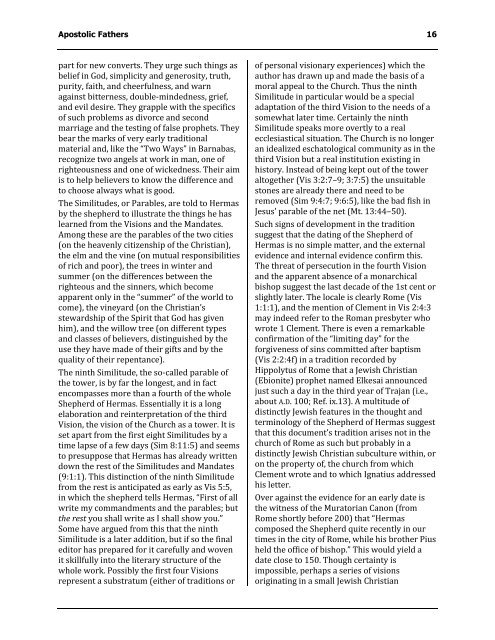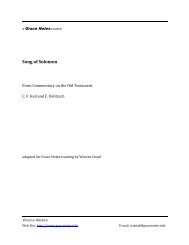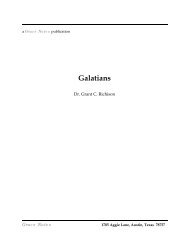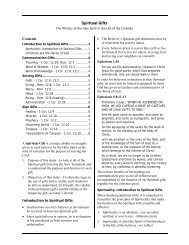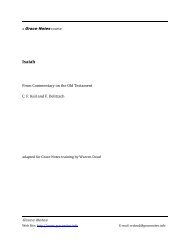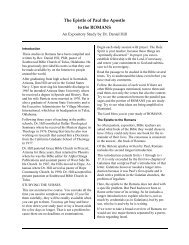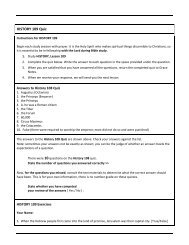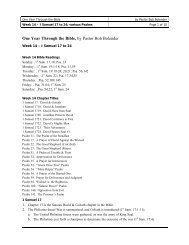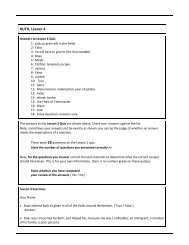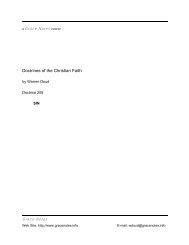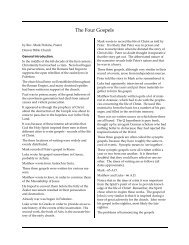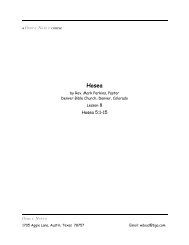You also want an ePaper? Increase the reach of your titles
YUMPU automatically turns print PDFs into web optimized ePapers that Google loves.
<strong>Apostolic</strong> <strong>Fathers</strong> 16part for new converts. <strong>The</strong>y urge such things asbelief in God, simplicity and generosity, truth,purity, faith, and cheerfulness, and warnagainst bitterness, double-mindedness, grief,and evil desire. <strong>The</strong>y grapple with the specificsof such problems as divorce and secondmarriage and the testing of false prophets. <strong>The</strong>ybear the marks of very early traditionalmaterial and, like the “Two Ways” in Barnabas,recognize two angels at work in man, one ofrighteousness and one of wickedness. <strong>The</strong>ir aimis to help believers to know the difference andto choose always what is good.<strong>The</strong> Similitudes, or Parables, are told to Hermasby the shepherd to illustrate the things he haslearned from the Visions and the Mandates.Among these are the parables of the two cities(on the heavenly citizenship of the Christian),the elm and the vine (on mutual responsibilitiesof rich and poor), the trees in winter andsummer (on the differences between therighteous and the sinners, which becomeapparent only in the “summer” of the world tocome), the vineyard (on the Christian’sstewardship of the Spirit that God has givenhim), and the willow tree (on different typesand classes of believers, distinguished by theuse they have made of their gifts and by thequality of their repentance).<strong>The</strong> ninth Similitude, the so-called parable ofthe tower, is by far the longest, and in factencompasses more than a fourth of the wholeShepherd of Hermas. Essentially it is a longelaboration and reinterpretation of the thirdVision, the vision of the Church as a tower. It isset apart from the first eight Similitudes by atime lapse of a few days (Sim 8:11:5) and seemsto presuppose that Hermas has already writtendown the rest of the Similitudes and Mandates(9:1:1). This distinction of the ninth Similitudefrom the rest is anticipated as early as Vis 5:5,in which the shepherd tells Hermas, “First of allwrite my commandments and the parables; butthe rest you shall write as I shall show you.”Some have argued from this that the ninthSimilitude is a later addition, but if so the finaleditor has prepared for it carefully and wovenit skillfully into the literary structure of thewhole work. Possibly the first four Visionsrepresent a substratum (either of traditions orof personal visionary experiences) which theauthor has drawn up and made the basis of amoral appeal to the Church. Thus the ninthSimilitude in particular would be a specialadaptation of the third Vision to the needs of asomewhat later time. Certainly the ninthSimilitude speaks more overtly to a realecclesiastical situation. <strong>The</strong> Church is no longeran idealized eschatological community as in thethird Vision but a real institution existing inhistory. Instead of being kept out of the toweraltogether (Vis 3:2:7–9; 3:7:5) the unsuitablestones are already there and need to beremoved (Sim 9:4:7; 9:6:5), like the bad fish inJesus’ parable of the net (Mt. 13:44–50).Such signs of development in the traditionsuggest that the dating of the Shepherd ofHermas is no simple matter, and the externalevidence and internal evidence confirm this.<strong>The</strong> threat of persecution in the fourth Visionand the apparent absence of a monarchicalbishop suggest the last decade of the 1st cent orslightly later. <strong>The</strong> locale is clearly Rome (Vis1:1:1), and the mention of Clement in Vis 2:4:3may indeed refer to the Roman presbyter whowrote 1 Clement. <strong>The</strong>re is even a remarkableconfirmation of the “limiting day” for theforgiveness of sins committed after baptism(Vis 2:2:4f) in a tradition recorded byHippolytus of Rome that a Jewish Christian(Ebionite) prophet named Elkesai announcedjust such a day in the third year of Trajan (i.e.,about A.D. 100; Ref. ix.13). A multitude ofdistinctly Jewish features in the thought andterminology of the Shepherd of Hermas suggestthat this document’s tradition arises not in thechurch of Rome as such but probably in adistinctly Jewish Christian subculture within, oron the property of, the church from whichClement wrote and to which Ignatius addressedhis letter.Over against the evidence for an early date isthe witness of the Muratorian Canon (fromRome shortly before 200) that “Hermascomposed the Shepherd quite recently in ourtimes in the city of Rome, while his brother Piusheld the office of bishop.” This would yield adate close to 150. Though certainty isimpossible, perhaps a series of visionsoriginating in a small Jewish Christian


